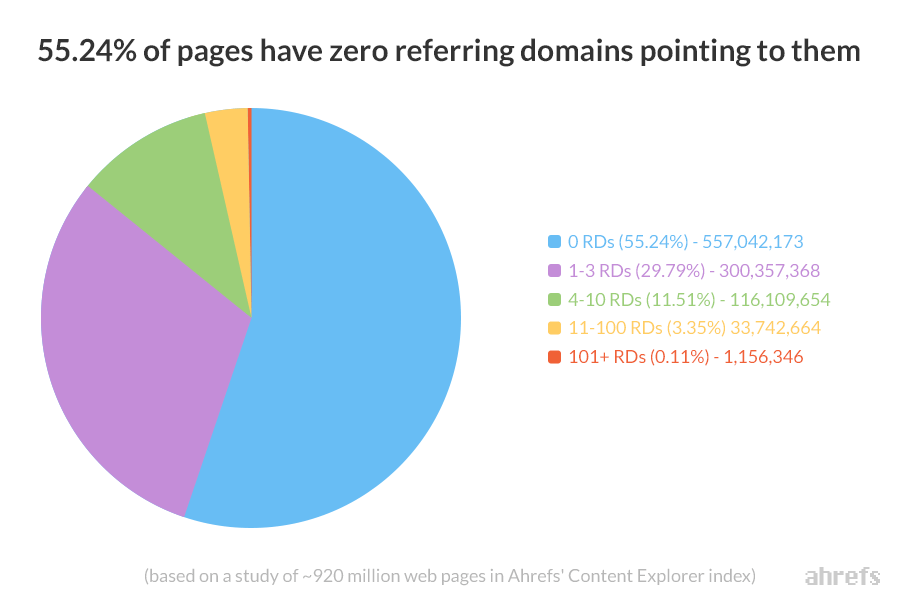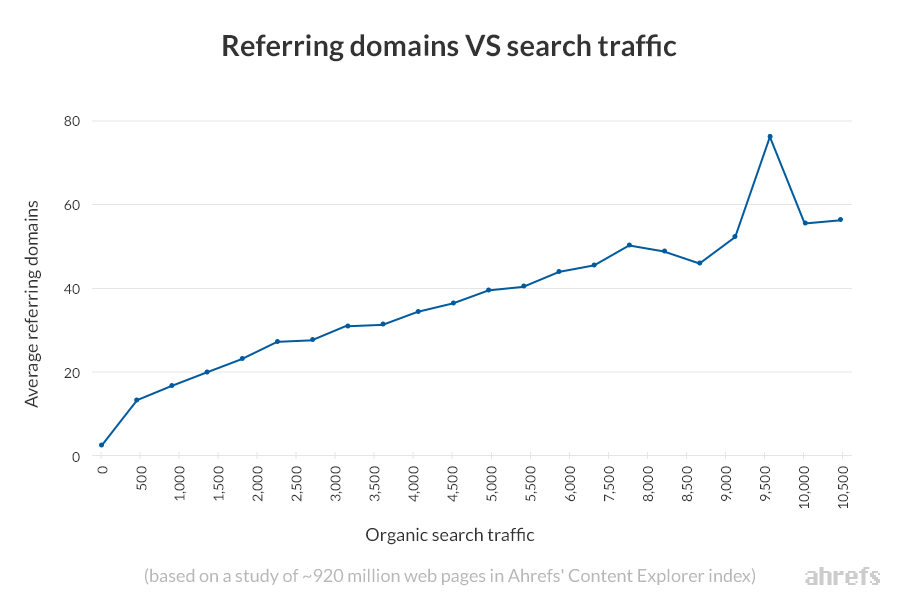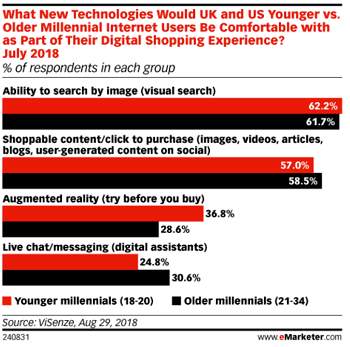1. In 2019 (to date), Google accounted for just over 75% of all global desktop search traffic, followed by Bing at 9.97%, Baidu at 9.34%, and Yahoo at 2.77%.
(Source: NetMarketShare)
To win at SEO, you have to play by Google’s rules. Ranking high on Yahoo or Bing will bring visitors to your site, but companies who rank on Google are most likely getting the most business.
Using Google Search Console will help you understand how people are currently getting to you through Google Searches.
Google’s strength can’t be denied in the search engine category. Keeping up with Google Algorithm changes ensures you’ll stay agile and can make key changes when they’re needed.
2. Google has received nearly 2.3 trillion searches this year.
(Source: Internet Live Stats)
Customers are searching…a lot.
In fact, consumers now do as much as 70% of their purchasing research online before they ever get into a sales conversation.
Ranking well in search engines enables your buyers to easily research on their own while spending time learning about your on your terms.
Prioritizing SEO gives you the power to do what you can to make sure your business appears first during those 2+ trillion searches.
3. Of the billions of searches that happen on a given day, 15% of daily searches are new to Google.
(Source: Google)
It’s important to remember that SEO isn’t only about competing with others trying to rank for the existing terms. With so many new searches happening every day, SEO is as much about getting found for new terms as it is for what’s already popular.
How do you rank for something new?
This is where Google’s BERT algorithm comes in.
With the much longer name of Bidirectional Encoder Representations from Transformers, BERT is a “neural network-based technique for natural language processing (NLP) pre-training.”
In other words, BERT looks at the context and intent of words in a series. So when you write with the intent to educate on a certain topic, BERT understands what you’re doing and rewards you for it.
There’s no secret, then, to “hacking” the BERT algorithm. The key is to write like a human.
4. On the first page alone, the first five organic results account for 67.60% of all the clicks.
(Source: Zero Limit Web)
Sure, your page analytics tools will show you what you’re ranking for on pages two through 10, but this stat shows that it really is good to be on top. With more than two-thirds of all clicks going to the first five organic results, the competitive field is tougher than ever and marketers need to be savvy, creative, and a little bit lucky to gain that prime real estate.
5. Google’s search algorithm uses more than 200 factors to rank websites.
(Source: Backlinko)
Google remains somewhat mysterious about exactly what and how they rank, but SEO experts the world over have been making lists (and checking them much more than twice) to pinpoint the magic of SERP ranking.
Backlinko has done a nice job of keeping this list up-to-date and it is comprehensive.
Even so, there is so many rather obvious and low-hanging fruit on the SEO tree.
6. High-quality content and link building are the two most important signals used by Google to rank your website for search.
(Source: Search Engine Watch)
That’s according to Andrey Lipattsev, Search Quality Senior Strategist at Google. And even though this stat was pulled from 2016, this still rings true today.
Quality content has consistently been a factor toward gaining traffic and ranking for your site/page, so it’s one thing we can expect to remain the same for the foreseeable future.
Focus on quality and honesty over quantity.
This will help your buyer see you as a trustworthy expert in your space. This also will help competitors or others in your industry see your site as valuable and worth returning to.
Before publishing, share your work with others in the industry or with your customers to ensure you’re spending time on valuable content.
7. 57% of marketing executives say on-page content development was the most effective SEO tactic.
(Source: Content Marketing Institute)
More than half of marketing professionals agree that content rules the roost when it comes to SEO.
On-page content goes much further than simply providing a wealth of information and keywords, however. This is why the average length of ranking content is getting longer every year.
8. The average content length of the top position Google article contains 2,416 words.
(Source: serpIQ)
How long does good content need to be? Enough to fully answer your buyers’ questions.
But if you want that good content to rank well, aim for the 2,000+ wordmark.
The more you write, the better informed your readers will be, the more you can show your transparency and honesty, the higher opportunity you’ll have to link out to other reputable sites, and likely the more backlinks you’ll receive.
As it turns out, backlinks are no joke when it comes to ranking.
9. The average word count of a voice search result page is 2,312 words.
(Source: Backlinko)
Long-form content rules the roost when it comes to voice search as well. This metric shows Google also tends to source voice search answers from articles that top 2,000 words.
Tempted to keep your stories short so you don’t scare off readers who won’t stick around to read a long article? You’re probably doing more harm than good.
10. 91% of all pages never get any organic traffic from Google, mostly due to the fact they don’t have backlinks.
(Source: Ahrefs)
A 2018 study by ahrefs looked at two million websites and found some pretty interesting data. While the word count factored into how a site ranks, it’s the backlinks that matter more.
On a related note…
11. 55.24% of pages don’t have a single backlink.
(Source: Ahrefs)
That same study mentioned in the state above highlights solidly more than half of the pages don’t have even one backlink. And another 30% have three or fewer backlinks.

This creates a huge opportunity for marketers to outrank their competitors by focusing on getting more backlinks to their content and site.
12. The more backlinks a page has, the more search traffic it gets from Google.
(Source: Ahrefs)
In a study of 920 million web pages, Ahrefs found that as traffic increased, so did the number of referring domains.
What’s the correlation?
That solid content you wrote — you know, the one with 2,000+ words — not only will answer your customer’s question, but it will satisfy other industry leaders who are also looking for strong content.
They’ll reward your effort with a link, and, in the process, increase your ranking along the way.

13. The top four ranking factors are website visits, time on site, pages per session, and bounce rate.
(Source: SEMrush)
According to SEMrush’s study on ranking factors, long, quality content and internal linking are also weighted heavily when it comes to being found.
But top-notch writing will only get you so far.
If you want your visitors to stay on your site, you’ll need to consider their needs, not only in terms of the content you provide but how they navigate through that content as well. This is called technical SEO and it just as big of a factor as on-page elements.
14. In 2019, 52% of all worldwide online traffic comes from mobile, 45% from desktop.
(Source: StatCounter)
Before you go changing everything to mobile, it’s important to look at the analytics specific to your site. These are global stats and may not represent what’s going on in your next of the cyber woods.
That said, even though desktop may have the edge for your site, you still need to be mobile-friendly if you want to compete regionally, nationally, and globally.
Also, the range of device sizes means it’s important for your website to be responsive, instead of just having one fixed size for mobile.
15. 36% of SEO experts think the headline/title tag is the most important SEO element.
(Source: Databox)
It’s tempting to spend the bulk of your time crafting the perfect copy for an article then to just want to move on. Because of this, we tend to treat the headline as an afterthought.
That’s a mistake, according to the majority of SEO experts surveyed recently.

Your headline will not only let the search engines know what you’re writing about, but there’s a good chance it will show up across social media feeds, in newsletters, and in all the backlinks you’ll receive.
Your audience will only click into that headline if it’s appealing enough to grab their attention.
Take the time to create multiple (at least three) versions that contain the keyword phrase you want to rank for. Then, workshop your title with coworkers and colleagues.
The time you put into crafting the perfect headline will pay off in traffic and ranking.
16. Long-tail keyword searches have a click-through rate 3% to 5% higher than generic searches.
(Source: Smart Insights)
While most searchers aren’t seeking out one- and two-word terms, they’re searching phrases that are four words or longer.
They’re looking for specifics.
Your content needs to reflect this.
It’s the difference between “SEO” and “SEO statistics” and “SEO statistics for 2020.”
See how those last searches are different? There’s unique intent with each of these, and the user expects different, more specific, and more updated content as the keyword gets longer.
Not sure how to create longer keywords? Consider The Big 5 questions your buyers are asking.
If you’re looking to rank for the keyword “SEO strategy,” for example, you could set your sights on the following long-tail keywords:
- How to create an SEO strategy
- What is an SEO strategy?
- What are the benefits of an SEO strategy?
- How do I get more website traffic?
- How much does an SEO strategy cost?
17. 70% of marketers see SEO as more effective than PPC.
(Source: Databox)
With digital marketing becoming more mature, it’s no surprise that companies are continually getting better at SEO — and seeing more results from SEO efforts than from PPC.
Many of the respondents reported that they see more results (including traffic, leads, and sales) from SEO. Others used ROI as a benchmark to rank SEO over PPC.
Marketers found SEO to be a long-term strategy, while PPC allowed for short-term bursts.
As one respondent said, “PPC feels like lifting a lead zeppelin. Put enough force (i.e. money) behind it, and traffic will come. But as soon as you stop paying, the traffic stops.”
18. More than 1.3 million businesses, website publishers, and nonprofits nationwide benefited from using Google’s advertising solutions.
(Source: Google)
Despite stat #17, the potential to turn a profit from devoting ad spend in Google Search is certainly there.
Those marketers who see SEO as the stronger strategy shouldn’t necessarily count out paid campaigns altogether.
19. 61% of marketers say improving SEO and growing their organic presence is their top inbound marketing priority.
(Source: HubSpot State of Inbound)
Because of the success of inbound marketing and SEO, more marketers are dedicated to improving their ranking over other tactics.
Your competitors most likely fit into this 61%, so now is the time to take SEO seriously.
20. “Where to buy” + “near me” mobile queries have grown by over 200% in the past two years.
(Source: Google)
If you’re a business that depends on local traffic or has a limited service area, this is key.
Local SEO tactics are important for smaller businesses that might not be blogging or creating a ton of content. Make sure your site is in the appropriate registries and all of your information is up to date.
If your site is not optimized for mobile or local search, it will not show up in mobile search results, and those local customers won’t be visiting your store.
21. 72% of consumers who did a local search visited a store within five miles.
(Source: WordStream)
To the point above, of those increased “near me” searches, those individuals actually visited the store. Not only will you show up in search, but they’re more likely to show up to your store.
22. Updating and republishing old blog posts with new content and images can increase organic traffic by as much as 106%.
(Source: HubSpot)
If you’ve had content that’s been sitting around for a while, historic optimization might just become your new best friend.
By updating and refreshing existing content, you not only get the benefit of getting more miles out of old articles, but you can reenergize how those oldies but goodies rank.
If you’ve got a strong baseline and were once ranking for keywords well with older articles, this is the perfect tactic to take back for your 2020 strategy.
23. Images are returned for 22.6% of search queries on Google.
(Source: Moz)
With the growing reliance on Pinterest, Instagram, and other visual-based platforms, consumers are looking for search results they can, well, look at.
24. 62% of Gen Z and Millennial consumers want visual search more than any other new technology.
(Source: ViSense)
Are images becoming the new keywords? The data certainly supports this.
If you haven’t started already, it’s time to build a plan for including visual search into your arsenal, beginning with prioritizing schema markup and metadata.

25. 40.7% of all voice search answers came from a featured snippet.
(Source: Backlinko)
Featured snippets have been around since 2014, but their dominance in voice search is continuing to grow.
As you create articles to gain SEO traction, keep your featured snippet game in mind as well.
Creating featured snippets isn’t as difficult as you may think, and the work you put into them will certainly pay off.
26. “Best” + “right now” mobile queries have grown by over 125% in the last two years.
(Source: Google)
When you consider the blog topics your audience wants you to write about, make sure to include a list of “Bests.”
Not only are mobile queries on the rise, but so are requests for best lists.
Think about how to include similar searches in your own strategy:
- Best commercial flooring options right now
- Best phone out right now
- Best investments to make right now
- Best SEO strategy right now
Key takeaways for your 2020 SEO strategy
Marketers are spending more time and money on SEO, which means the competition for the top spots will continue to heat up.
Providing value to your customer is still the best approach to ranking in search engines, so keep writing quality content and designing top-notch user experiences.
Mobile is increasingly becoming a larger factor in ranking, especially when it comes to local marketing.
There’s so much to consider when developing an SEO strategy, especially when so much is changing year to year.
Staying up-to-date on SEO statistics and working their data into your strategy can set you up for a long-term roadmap. And performing a technical SEO audit is a helpful way to hone your strategy and create some quick SEO wins. Together, you’ll be prepared to enter 2020 with a plan for both short- and long-term success.

